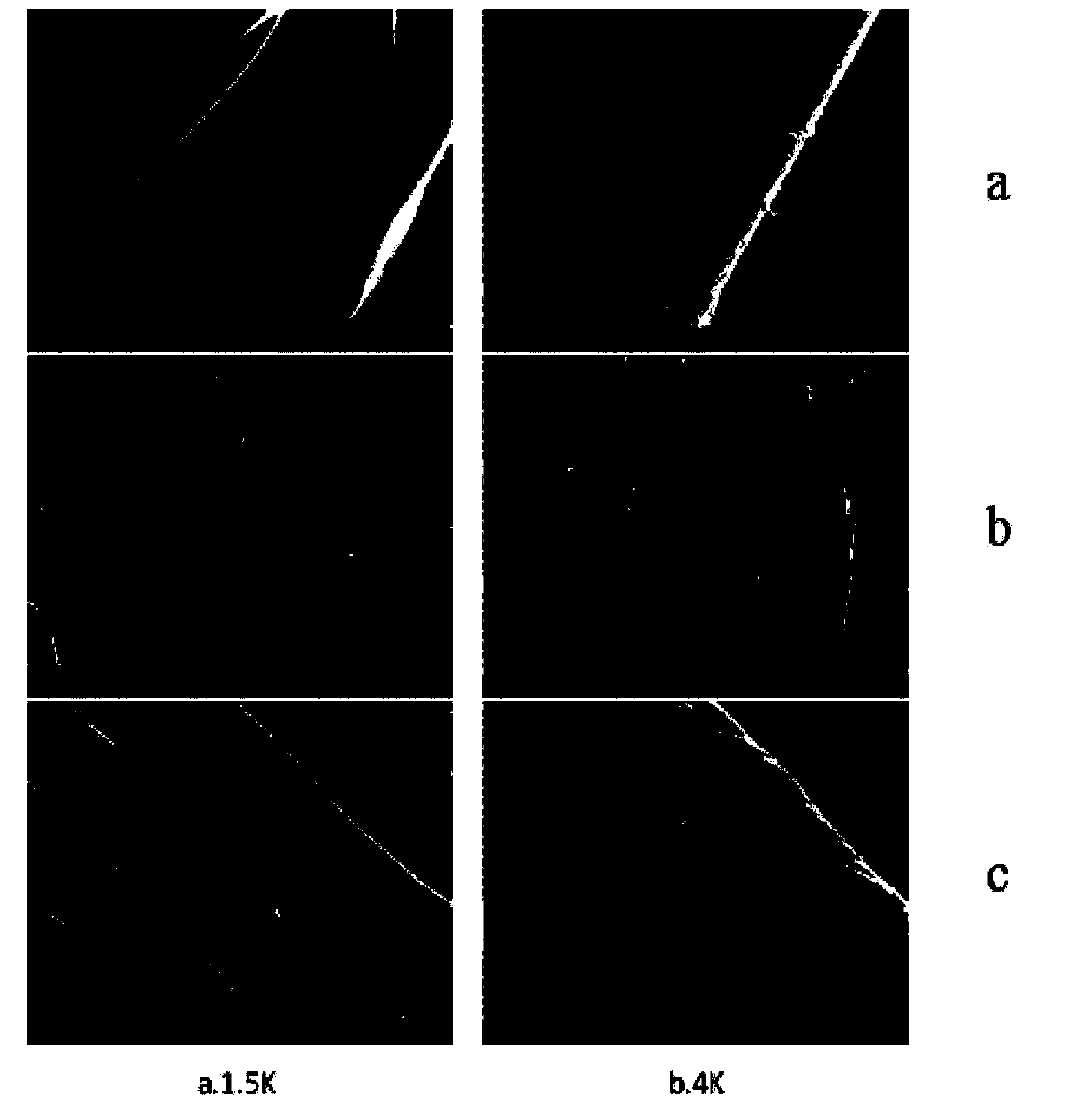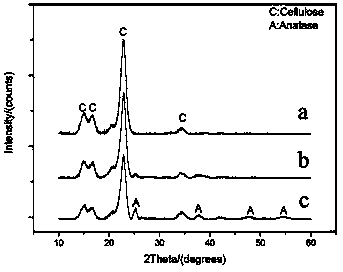Nano-titanium dioxide sol finishing agent prepared at low temperature and application thereof
A nano-titanium dioxide and finishing agent technology, applied in the direction of titanium dioxide, titanium oxide/hydroxide, fiber treatment, etc., can solve problems such as high temperature, growth of crystal particles, premature aging of fiber materials or adhesives, and achieve Effect of low temperature and improved photocatalytic performance
- Summary
- Abstract
- Description
- Claims
- Application Information
AI Technical Summary
Problems solved by technology
Method used
Image
Examples
Embodiment 1
[0041] The 32×32 68×68 cotton fabric was treated with water steaming process, and then its crystal form was characterized by X-ray diffractometer (X'pert Powder).
[0042] Water boiling process: fabric drying→impregnation of nano-titanium dioxide sol for 30s→two dipping and two padding (finishing agent concentration 20g / L, liquid rolling rate 80%)→pre-baking (80°C, 5min)→baking (97°C, 6min) →Steam in boiling water for 180min→Dry.
[0043] The X-ray diffraction patterns of cotton fabrics treated with different finishing processes are as follows: figure 1 Shown, (a) unfinished (b) baking treatment (c) water boiling treatment. The water-boiling-steamed fabrics have strong diffraction peaks around 2θ of 25.3, 37.8, and 48.0, which correspond to (101), (004), and (200) crystal planes of anatase, respectively, and have better crystallization properties. However, in the conventional rolling and baking process, the characteristic absorption peak of anatase nano-titanium dioxide is n...
Embodiment 2
[0048] The 32×32 68×68 cotton fabric was treated with water steaming process, and then its surface was characterized by S-3400-N scanning electron microscope.
[0049] Water steaming process: fabric drying→impregnation of nano-titanium dioxide sol for 30s→second dipping and second rolling (finishing agent concentration 20g / L, liquid rolling rate 80%)→pre-baking (80°C, 5min)→baking (97°C, 6min)→ Boil and steam for 180min → dry.
[0050] figure 2 SEM comparison of cotton fabrics with different finishing processes, (a) unfinished (b) baking treatment (c) water boiling treatment. figure 2 It shows that the dry and hot environment of baking makes the sol film syneresis, and the continuous film layer cannot be formed after drying, and the titanium dioxide film does not form a good combination with the fiber, and it is easy to peel off; A continuous and complete film layer.
Embodiment 3
[0054] Embodiment 3 treats the anti-ultraviolet performance of cotton fabric with different finishing processes
[0055] The 32×32 68×68 cotton fabric was treated with water steaming process, and then its UV resistance was measured with an ultraviolet transmission analyzer (UV1000F).
[0056] Water steaming process: fabric drying→impregnation of nano-titanium dioxide sol for 30s→second dipping and second rolling (finishing agent concentration 20g / L, liquid rolling rate 80%)→pre-baking (80°C, 5min)→baking (97°C, 6min)→ Boil and steam for 180min → dry.
[0057] Durability test: After the treated fabric is washed 10 times, its anti-ultraviolet effect is tested.
[0058] Table 1. UV protection properties of cotton fabrics before and after different processes
[0059]
[0060] The UPF value of the fabric treated by baking method decreased by 34.5% after washing; while the UPF value of the fabric treated by water boiling method decreased by only 10% after washing.
PUM
 Login to View More
Login to View More Abstract
Description
Claims
Application Information
 Login to View More
Login to View More - R&D
- Intellectual Property
- Life Sciences
- Materials
- Tech Scout
- Unparalleled Data Quality
- Higher Quality Content
- 60% Fewer Hallucinations
Browse by: Latest US Patents, China's latest patents, Technical Efficacy Thesaurus, Application Domain, Technology Topic, Popular Technical Reports.
© 2025 PatSnap. All rights reserved.Legal|Privacy policy|Modern Slavery Act Transparency Statement|Sitemap|About US| Contact US: help@patsnap.com



